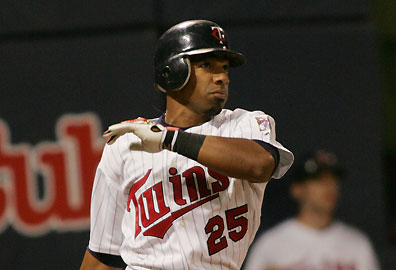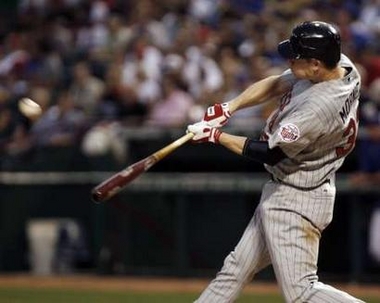July 29, 2008
Twins Notes: Casilla, Slowey, Hawkins, Ruiz, and Morneau
After a forgettable 2007 season and putrid 32-game stretch at Triple-A to begin this year, Casilla was called up from Rochester in mid-May and quickly took over as the everyday second baseman while helping to jump-start the offense. He provided the lineup with a speedy, patient, switch-hitting on-base threat in front of Joe Mauer and Justin Morneau, batting .313/.351/.424 with 19 extra-base hits and a 25-to-16 strikeout-to-walk ratio while driving in or scoring 77 runs in 62 games.
 With Casilla out indefinitely the Twins will make Nick Punto the starting second baseman while playing Brendan Harris at shortstop. That's backward in the sense that Punto has significantly more range and is simply a better defensive shortstop, but Ron Gardenhire feels that Harris' inability to consistently turn double plays as a second baseman makes him a better option at shortstop, poor range and all. To fill Casilla's spot on the roster, the Twins have activated Adam Everett from the DL.
With Casilla out indefinitely the Twins will make Nick Punto the starting second baseman while playing Brendan Harris at shortstop. That's backward in the sense that Punto has significantly more range and is simply a better defensive shortstop, but Ron Gardenhire feels that Harris' inability to consistently turn double plays as a second baseman makes him a better option at shortstop, poor range and all. To fill Casilla's spot on the roster, the Twins have activated Adam Everett from the DL.
Everett has been out since mid-May with a shoulder injury and was on the verge of being designated for assignment before news of Casilla's injury hit. Now he'll rejoin the team as a reserve while trying to show that his shoulder is healthy after the once-elite defender struggled to make even routine throws early this season. A healthy Everett can make up for his awful bat with his great glove and be a decent option at shortstop, but he's useless at less than full strength. Casilla will definitely be missed.
 Slowey also tossed a complete-game shutout against the Brewers on June 29 and is now tied for the league lead as one of just five AL pitchers to have two such outings this season. If you're curious, Scott Baker has one complete-game shutout in 64 career starts, Livan Hernandez hasn't had one since July 30, 2004, and Nick Blackburn, Glen Perkins, and Boof Bonser have zero in 97 starts between them. Here's how Slowey's numbers in the majors compare to his time at Double-A and Triple-A:
Slowey also tossed a complete-game shutout against the Brewers on June 29 and is now tied for the league lead as one of just five AL pitchers to have two such outings this season. If you're curious, Scott Baker has one complete-game shutout in 64 career starts, Livan Hernandez hasn't had one since July 30, 2004, and Nick Blackburn, Glen Perkins, and Boof Bonser have zero in 97 starts between them. Here's how Slowey's numbers in the majors compare to his time at Double-A and Triple-A:
PA SO% BB% HR% BIP
AA/AAA 785 21.4 4.2 1.5 .270
Majors 684 17.0 3.9 4.2 .282
Slowey made a name for himself in the minors with pinpoint control and amazing strikeout-to-walk ratios, and for all the reactionary talk of his supposed lack of an "out-pitch" that's exactly what he's done in the majors. With just 27 walks in 163.1 innings his control has actually been even better than it was in the high minors and while his strikeout rate has fallen 20 percent, it remains above the AL average. A huge increase in homers allowed is the biggest change for Slowey, but that was to be expected.
Monday's ground-ball fest against the White Sox not withstanding, he's always been an extreme fly-ball pitcher and warning-track outs in the minors tend to become homers in the majors. From Brad Radke, Johan Santana, and Eric Milton to Slowey, Baker, and Perkins, the Twins' rotation has long been filled with fly-ball pitchers who in turn struggle to keep the ball in the ballpark. Homers are Slowey's biggest weakness, but the many fly balls also help account for his low batting average on balls in play.
As noted Monday, Hawkins' ugly ERA this season overstates how poorly he's pitched. A deeper look at his performance shows that he's essentially been Jesse Crain's equal, both this season and for the past four years. Crain is currently the Twins' secondary setup man and has been handed quite a bit of high-leverage work since Pat Neshek's season-ending injury, which suggests that the team could use a similarly effective reliever. He's nowhere near the pitcher he once was, but Hawkins could help.The Twins are interested in former teammate LaTroy Hawkins to help shore up their bullpen, according to two persons familiar with the situation. Hawkins was designated for assignment Saturday by the Yankees, after they landed reliever Damaso Marte from the Pirates, and the Yankees have 10 days either to trade him or send him through waivers.
Hawkins, 35, went 1-1 with a 5.41 ERA in 33 appearances for the Yankees, but the Twins' thinking is that a return to where he developed into a good setup man could turn his season around. ... If Hawkins is dealt, the acquiring team would have to pay roughly $1.25 million of the $3.75 million he's making this season. If he's released by the Yankees, he could sign with any club for the league minimum, but Hawkins has drawn enough interest from clubs that a trade seems more likely.
After breaking free from his track record by hitting .340/.434/.481 with 15 extra-base hits and a 36-to-26 strikeout-to-walk ratio in 40 games at Triple-A to begin this year, Span has hit .313/.403/.446 with 10 extra-base hits and a 19-to-17 strikeout-to-walk ratio through 36 games in the majors. His trip back to earth likely isn't done yet, but with each game he looks more like a legit leadoff man and less like a fourth outfielder. With Casilla out, the Twins desperately need him to keep getting on base.
Monroe has hit .202/.274/.405 in 179 plate appearances with the Twins. Ruiz has hit .313/.360/.514 in 442 plate appearances at Triple-A. He's far from a potential star and has plenty of flaws, but Ruiz is on track for his 10th straight season with an OPS above .800 in the minors and would have been a fine fit as a right-handed platoon partner for Jason Kubel at designated hitter. Instead, the Twins spent an extra $3.5 million on Monroe, who's now hit .234/.285/.431 over his last 1,200 plate appearances.A 30-year-old veteran of nine seasons and over 3,600 trips to the plate in the minors, Ruiz has yet to get even a sniff of the big leagues despite a .300/.370/.522 career hitting line. ... He has a lengthy track record of success in the minors and looks capable of filling a specific niche in the majors as a right-handed platoon bat, but unfortunately for Ruiz he picked the wrong year to make the Twins.
I'd argue that signing a scrap-heap bat like Ruiz for $350,000 makes more sense than handing $3.8 million to Monroe, but that ship sailed months ago. ... Strictly in terms of hitting ability the only real difference between Monroe and Ruiz is that the Tigers gave Monroe a chance in 2003 after he put up a string of impressive seasons in the minors. Ruiz has yet to get that chance and probably won't.
Beyond that, Morneau continues to swing at pitches outside the strike zone at a remarkably consistent rate. From 2006-2008, he swung at non-strikes 30.7, 31.1, and 30.4 percent of the time. While walking like crazy over the past month, he's swung at pitches outside the strike zone 30.9 percent of the time. Morneau isn't suddenly laying off more non-strikes. Instead, he's being thrown more non-strikes and because he's always avoided swinging at them 70 percent of the time, he's drawing more walks.
 Over the past three seasons, 49.1 percent of the pitches thrown to Morneau have been inside the strike zone, but during the past month that number has dropped to just 41.7 percent. One area where he's definitely improved in July is making contact on pitches both inside and outside the strike zone. This month he's connected on 96.0 percent of his zone swings and 70.4 percent of his non-zone swings, both of which are up considerably from his pre-July rates this year and for his career.
Over the past three seasons, 49.1 percent of the pitches thrown to Morneau have been inside the strike zone, but during the past month that number has dropped to just 41.7 percent. One area where he's definitely improved in July is making contact on pitches both inside and outside the strike zone. This month he's connected on 96.0 percent of his zone swings and 70.4 percent of his non-zone swings, both of which are up considerably from his pre-July rates this year and for his career.
Morneau has hit .320/.393/.526 with 17 homers, 26 doubles, 48 walks, 64 runs, and 82 RBIs in 106 games. At this same point during his MVP-winning 2006 season, he was hitting .319/.367/.596 with 28 homers, 20 doubles, 30 walks, 62 runs, and 88 RBIs. Given that offense is down seven percent across the league this year compared to 2006--a difference that equals 30 points of OPS or one-third of a run per team, per game--a good argument can be made for his current run being even more impressive.
Once you're done here, check out my latest "Daily Dose" column over at Rotoworld.

